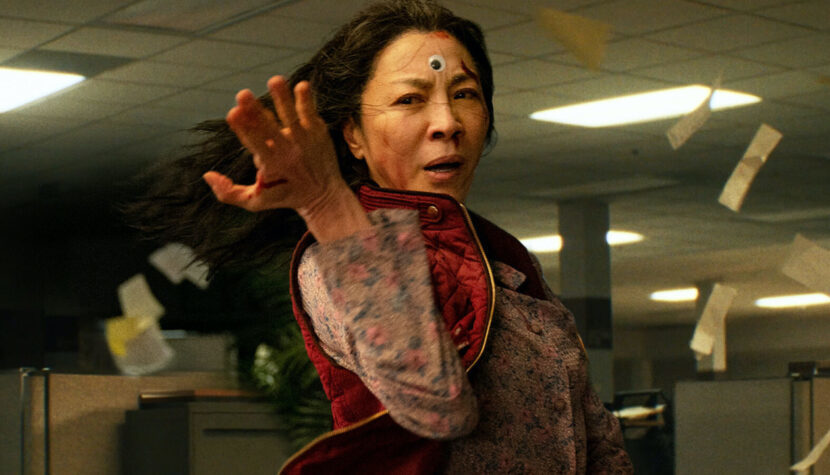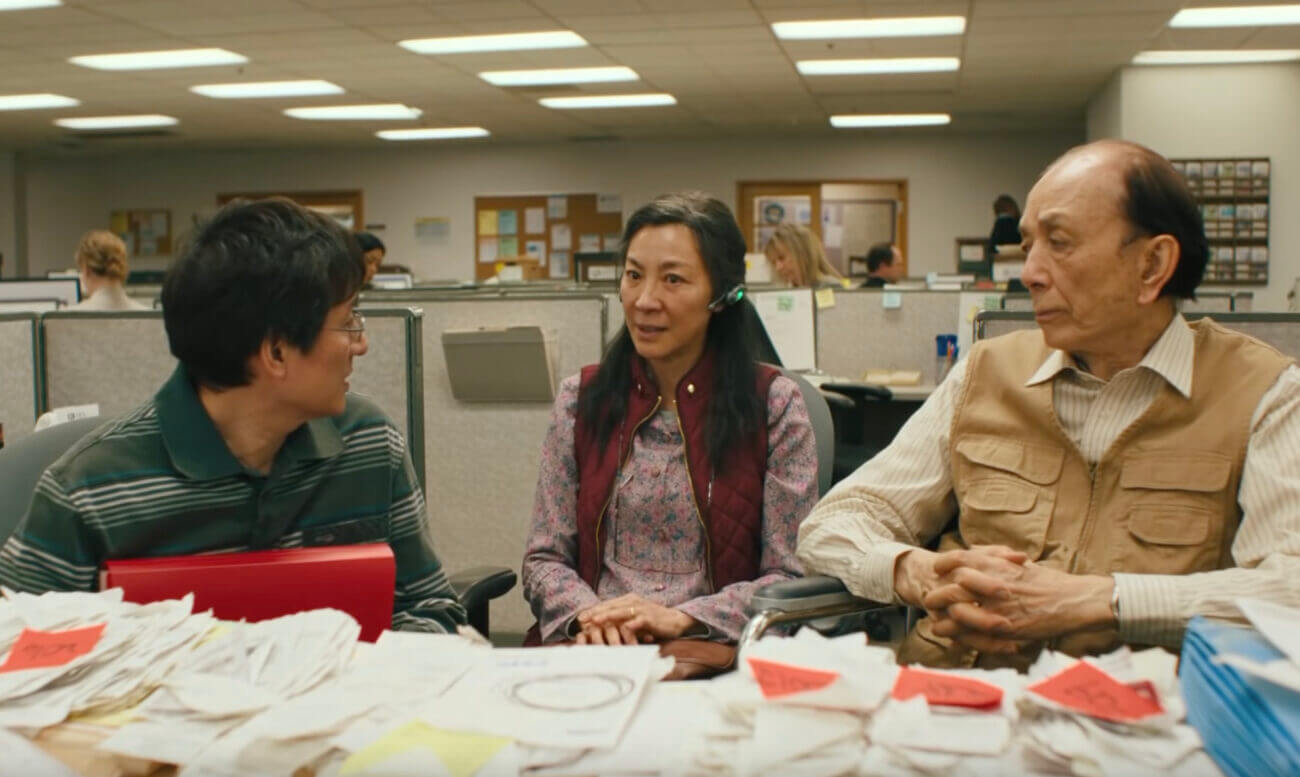EVERYTHING EVERYWHERE ALL AT ONCE. Evelyn Wang in the Multiverse of Madness

Too much is going on in Evelyn Wang’s (Michelle Yeoh) life. Accounting inaccuracies in a struggling laundromat drive her company to the brink of bankruptcy. A withdrawn husband (Ke Huy Quan) silently requests a divorce by placing the relevant papers on top of a desk littered with papers. A demented father (James Hong) doesn’t know where he is or what his purpose is. Finally, there is the rebellious daughter (Stephanie Hsu), with whom the heroine, despite her attempts, cannot find a common language. Accumulating problems attack Evelyn simultaneously, without mercy and without warning – everywhere at once.
An intense prologue, made with the use of long, moving shots, promises a solid existential drama focused on family and financial problems. And yes, that’s what Everything Everywhere All at Once is, but only to a certain extent. The film is directed by Daniel Scheinert and Dan Kwan – one of the most creative duos of contemporary American cinema, responsible, among others, for for the excellent Swiss Army Man and memorable music videos for such songs as Turn Down For What by DJ Snake and Lil Jon or Houdini and Don’t Stop by Foster The People. If you know at least one of these crazy works, it’s really hard to be surprised when the whole world presented All at once turns upside down at some point. During a visit to the tax office, Evelyn is contacted by Alpha Waymond (a charismatic and combative version of her husband, coming from an alternate universe), informing the heroine that she is the last hope to stop a certain Jobu Tupaki, a chaos-loving creature who destroys every universe that haunts . From an existential drama, although the entire plot remains lined with it to the end, Daniels’ film transforms into crazy science fiction, constantly questioning and expanding the boundaries of our imagination.

Everything Everywhere All at Once is a fairly extreme representative of postmodern cinema. And it’s not just about the multitude of pop culture references flooding the screen from every side (this is probably the only film in which Ratatouille meets Wong Kar-Wai, and The Matrix enters into a dialogue with 2001: A Space Odyssey). Daniels’ work in a very conscious and, above all, funny way, pastiches almost every genre and form possible (as Frederic Jameson rightly observed: “in a world where stylistic innovation is impossible, all that remains is to imitate dead styles, put on linguistic masks, speak with voices from the museum of imagination”): science fiction, adventure, action, romance, family drama, comedy of absurdities, superhero movies, wuxia, cartoon animation and stop-motion … The list seems to be endless. The duo moves around the stylistic map of cinema in an extremely free and nonchalant way (just like the characters they created between successive worlds), somewhere in the meantime collecting into their creative basket those elements that suit them, and then building a completely new creation on the basis of them , delighting with its originality and creativity.
Daniels’ film is also characterized by a two-code character characteristic of postmodernism. It can be read very literally – as an adventure fighting to save Evelyn’s multiverse. You can also treat the absurd vicissitudes of the main character, which the creators openly encourage, as a veiled, emotional story about breaking family ties. You can ignore all pop culture references and still have a great time following the dynamic development of on-screen events. You can also, just like in the case of Shrek, Pulp Fiction or Under the Silver Lake (in Mitchell’s film, this process is additionally thematized), notice and analyze numerous audiovisual references, thus deriving additional pleasure from the screening. Everything depends on us, or rather on our cultural competences, put to the test by Scheinert and Kwan.

An additional advantage of Everything Everywhere All at Once are the perfectly created characters. In the foreground is Michelle Yeoh – an Asian star who has so far been able to count on supporting roles in major Hollywood productions (Shang-Chi and the Legend of the Ten Rings, Crazy Rich Asians, The Mummy: Tomb of the Dragon Emperor, Tomorrow Never Dies). In Daniels’ film, the actress has a chance to show the fullness of her talent, playing a dozen different versions of the same character. Most admirable, however, are the numerous action scenes, during which Yeoh, 59, impresses with her physical prowess as she dances between opponents and deals deadly blows after another. For those who remember Crouching Tiger, Hidden Dragon, it will probably be a surprise – the Malaysian is still in great shape. She is followed in the first place by Ke Huy Quan (who combines the experience gained on the sets of Steven Spielberg and Wong Kar-Wai’s films in Everything Everywhere All at Once) and Jamie Lee Curtis, who has a fantastic time playing the role of a demonic accountant – a character definitely more complex than one could imagine beginning to spend.
The most impressive and effective weapon of Daniels is, at least on a technical level, parallel assembly. The creators use it almost non-stop, which should not surprise anyone – the action takes place here over a dozen universes. Although complicated and multi-threaded, the plot remains clear to the viewer precisely because Daniels and their talented editor Paul Rogers, who previously collaborated with Scheinert on Dick Long is Dead, are so excellent at operating this specific type of editing, without losing our interest even for a second. . Using it, they build a story, jokes and, above all, tension. Directing skills, with parallel editing at the forefront, Scheinert and Kwan mastered on the sets of music videos, where stories are most often told through aggressive series of images (my favorite is the video clip for the song Houdini, in which Daniels presented capitalist exploitation in an extremely funny, grotesque way “dead” members of the band Foster The People), as well as during the production of the last two shorts – Interesting Ball and Possibilia – a crazy mosaic with a mysterious ball provoking the development of supernatural events in the center and an interactive short based on the breakup of a close relationship, the action of which takes place as the caption at the beginning of the film says, “into the multiverse”. Everything Everywhere All at Once can be treated as a very successful development of the plot concept from Possiblia and the technical construction from Interesting Ball.

Under a thick layer of absurdity, Daniels’ work often hides a surprisingly serious, deeply humanistic message. In the case of the Swiss Army Man, it was an instructive lesson about leaving, loneliness and male friendship. In Everything Everywhere All at Once – a few words of wisdom about the generational conflict, everyday attitude towards other people, caring for family ties and those brief moments of happiness when everything clicks into place and our existence, despite its undeniable flaws and limitations, seems to be home perfectly tailored to us. Sometimes you have to work patiently for a moment like this all your life. Sometimes it attacks us suddenly, without warning – everywhere and at once.


